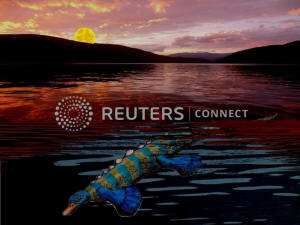|
Odd duckbilled sea reptile thrived after
ancient global calamity
 Send a link to a friend
Send a link to a friend
 [January 25, 2019]
By Will Dunham [January 25, 2019]
By Will Dunham
WASHINGTON (Reuters) - In shallow warm seas
about 247 million years ago in what is now China, an oddball marine
reptile flourished in the aftermath of Earth's worst mass extinction,
possessing a duckbilled snout and unusually small eyes that made it
resemble a platypus.
Scientists on Thursday described fossils of the three-foot-long (one
meter) creature, called Eretmorhipis carrolldongi, that boasted a head
that looks too little for its body and weak vision that indicates it
relied upon a sense of touch, not sight, to forage in murky water using
its cartilaginous bill.
Eretmorhipis, previously known only from headless skeletons before new
fossils were unearthed in Hubei province, appeared early in the Triassic
Period in the wake of a mass extinction 252 million years ago, possibly
caused by immense Siberian volcanic activity, that erased roughly 90
percent of species at the end of the Permian Period.
"It has this very strange combination of features," said paleontologist
Ryosuke Motani of the University of California, Davis, also including
four big flippers, triangular bony blades on its back and a stiff, bony
body trunk.

"A person seeing it would probably say, 'Bizarre,' or, 'How weird.' I
think I said, 'What?' when I first saw it," Motani added.
Researchers have documented a quick and dynamic rebound in marine
ecosystems in a time of evolutionary experimentation after the die-off
as new creatures filled ecological niches vacated by extinct ones,
facing little competition.
"You did not have to be optimally tuned to survive. If this species was
introduced to today's ecosystem, it would not stand a chance of
survival," Motani said.
[to top of second column]
|

Artist's impression of the Triassic Period marine
reptile Eretmorhipis carrolldongi, which evolved in a world
devastated by the mass extinction event at the end of the Permian
Period. Gianluca Danini/Handout via REUTERS

Eretmorhipis, which lived roughly 17 million years before the first
dinosaurs, superficially resembles a duckbilled platypus, the
primitive, semi-aquatic, egg-laying mammal from Australia. The bone
structure supporting the bill in both creatures is similar, as is
the reduced eye size.
This is an example of a phenomenon called convergent evolution in
which unrelated organisms acquire similar characteristics in
adapting to similar environments, often separated by many millions
of years, Motani said. Another example is birds, bats and the
extinct flying reptiles called pterosaurs all evolving wings for
flight.
A slow-moving predator, Eretmorhipis probably foraged at dusk or
night for soft invertebrates like worms and shrimp. It was closely
related to ichthyosaurs, a marine reptile group that arose about 249
million years ago and disappeared about 90 million years ago.
Eretmorhipis is the oldest creature and only marine reptile known to
have had a bill. While its bill also superficially resembles that of
a duck, its underlying structure is considerably different.
The research was published in the journal Scientific Reports.
(Reporting by Will Dunham; Editing by Sandra Maler)
[© 2019 Thomson Reuters. All rights
reserved.]
Copyright 2019 Reuters. All rights reserved. This material may not be published,
broadcast, rewritten or redistributed.
Thompson Reuters is solely responsible for this content. |